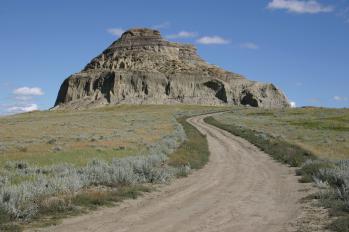
(49°03' 00”N, 104°51' 00”W; Map sheet 72 H/2). Located 200 km south of Regina, in one of the driest, most rugged environments in the province, the banks of the Big Muddy Valley are so far apart that its floodplain is 3 km wide in places. Some 60 km in length and up to 160 metres deep, the Big Muddy was part of an ancient glacial melt water channel that carried vast quantities of water southeastward at the end of the last ice age. The waters that carved the Big Muddy were then considerably more abundant than the many ephemeral creeks and springs that now grace this landscape of sandstone cliffs and buttes. Hidden away from any public roads, shallow and alkali Big Muddy Lake sits 140 m below the surrounding landscape, as the only reminder of times when waters flowed more generously through the valley.
The Big Muddy may have been visited by Plains nomadic societies as early as 10,000 years ago. Occupation and buffalo kill sites indicate that the landscape has long sustained human occupation. The variety of stone circles, and turtle and buffalo effigies in the area suggests that this badlands region was associated with ritualistic events or ceremonies. What drew them there? Resources such as bison and berries, sheltered areas, abundant fresh water and fuel, and a likely central position in the worldviews of local indigenous populations made the Big Muddy a favoured destination throughout the cycle of seasons.
The aesthetic qualities of this extraordinary landscape may have inspired ranchers and early settlers to come here, as much as the relative freedom of living in a remote area. Ironically, the level of isolation also contributed to less savoury activities. Because of its location near the American border, the Big Muddy attracted bandits and horse thieves needing a refuge north of the 49th parallel. Patrolling the region was a challenge for the North-West Mounted Police because local ranchers, who wanted no trouble from these ruffians, often turned a blind eye to illegal activities. Contemporary visitors enjoy less intrusive activities such as observing the blooming prickly pear cactus and hiking around the base of Castle Butte, which reaches 60 m in height and is known informally as the flagship attraction of the Big Muddy Valley.
Claude-Jean Harel